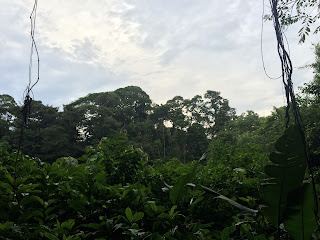One
Paraponera, two Paraponera, three Paraponera,
four. Look, there is a nest on the floor. Let’s poke it with a stick to make
sure.
It may not have been the best way to find the
nests of Paraponera clavata, also
known as the bullet ant, but it did work. For our independent project, my
partner and I needed to explore the La Selva Biological Station in depth in
order to find a substantial number of bullet ant nests to test our hypothesis.
So, we hit the trails searching for medium sized, smooth-barked trees that
seemed to be suitable sites for P.
clavata activity. If we saw more than one bullet ant in one area, we
investigated the dirt at the base of the trees surrounding us until we found a
possible site for a nest, which we then continued to poke with a rather large
stick. If there was a nest there, ants would spill out of its tiny opening and
yell at us with a squeaking noise. We were able to find 13 nests using this
strategy. Though the reward of finding another nest was not the best part of
our quest, it was being able to go out into the lowland wet forest every day.
My partner and I were able to
experience Costa Rican rainforest extensively. We slowly trekked across twelve
trails at the La Selva Biological Station while looking for P. clavata nests. While we may not have
had the ability to enjoy the luxury of an air conditioned lab like our peers,
we were able to see the beauty and mysticism that lay deep within the forest. Some
trails offered scenic landscapes of forest framing a picturesque, glittering
river at sunset. Other trails showed off awe inspiring snakes, frogs,
butterflies, and spiders. One trail presented us the opportunity to get caught
in a heavy thunderstorm, in the middle of the rainforest, while being about an
hour away from the station. It was exhilarating.
The experience of walking those trails was so
surreal, I couldn’t believe that I
was actually there taking part in it all. The deeper I hiked into the forest,
the more I was becoming part of the environment. I felt less like an intruder
and more like resident of this very large home. I felt like the animals and
insects were my neighbors and the trees that bordered the trail became the
walls that I could walkthrough of a house and the leaves of the canopy as its
roof.
Each morning started with a strong
cup of coffee at breakfast, clean clothes, and the ticking off of boxes on a
mental check list on what to bring for that day’s excursion. Each day ended
with mud covered clothes, another blister, and a well-deserved shower. No
matter how tired I became, no matter how much my feet hurt, no matter how hot
and dirty I felt, I did not complain. I knew what I was seeing and doing was a
series of events that rarely occur in a lifetime. I traveled half-way across
the world to Costa Rica to have those experiences. Though becoming extremely
muddy and sweaty while hiking through heat and humidity and sometimes getting
caught in the rain may not have been everyone’s version of a good time, it was
certainly mine and I was not going to take that for granted. I wanted to fully
experience the rainforest and that is exactly what happened. Who knew that
searching for such small creatures would lead me to see such enchanting places?
Jessica
Andreone
Syracuse
University



Hi, Jessica. Wonderful piece. I feel like that almost every day, being fortunate enough to live here most of the year. Those feelings you so well describe are the inspiration, the core sentiments of a tropical field biologist. Maybe none of us will ever become materially rich doing this but we are rich in many other ways.
ReplyDeleteThank you for sharing these experiences with us.
Carlos